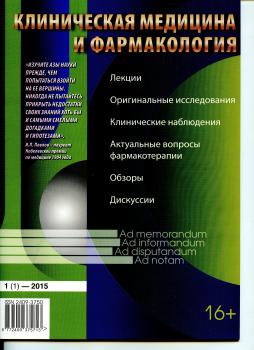Tula, Tula, Russian Federation
Russian Federation
Russian Federation
Russian Federation
Russian Federation
Russian Federation
Russian Federation
The purpose of the study is to detail the information about the peculiarities of the chemical composition and structural organization of different groups of compounds of organic matter, yarrow, revealing the influence of nature of the extractant on the qualitative composition and quantitative content of extractable compounds in the obtained chloroform extract, and identifying new pharmacological actions of the latter, the extension of the range of compounds already known in the literature on herbal medicine. Materials and methods of research. The chemical composition of the chloroform extract was studied by chromatography-mass spectrometry under the following conditions. The chemical composition of the ethanol extract of yarrow was used by chromatography-mass spectrometry under the following conditions. GC-2010 gas chromatograph connected to a triple quadrupole mass spectrometer GCMS-TQ-8030 running GCMS Solution 4.11 software. Identification and quantitative determination of the content of compounds were performed under the following chromatography conditions: sample input with flow division (1:10), ZB-5MS column (30m × 0.25 mm × 0.25 mm), injector temperature 280 °C, carrier gas-helium, gas velocity through the column 29 ml/min. Conclusion. For the first time, the chemical composition of chloroform extract, a product of sequential exhaustive extraction of yarrow by chromatography — mass spectrometry, was studied, which allows identifying 94 individual compounds for which mass spectra and structural formulas were obtained, the quantitative content was determined, and the structural and group composition of the extract was calculated. The basis of the composition of the chloroform extract is determined by hydrocarbons enriched with arenes, alkenes and alkynes, esters formed mainly by oxalic and benzoic acids, polyunsaturated fatty carboxylic acids, steroid compounds, alcohols, nitrogen-containing structures that include individual fragments of natural alkaloids, as well as a variety of organosilicon compounds that determine the main directions of pharmacological action of various yarrow preparations, including chloroform extract.
yarrow, chloroform extract, chromatography and mass spectrometry.
1. D'yakova N.A., Velikanova L.A., Shishorina L.A., Bobina E.A. Osobennosti nakopleniya flavonoidov travoy tysyachelistnika obyknovennogo sinantropnoy flory central'nogo chernozem'ya. V knige: Fundamental'naya nauka i klinicheskaya medicina - chelovek i ego zdorov'e. XXIII Mezhdunarodnaya mediko-biologicheskaya konferenciya molodyh issledovateley, posvyaschennaya 25-letiyu medicinskogo fakul'teta SPbGU. Materialy nauchnoy konferencii. 2020. S. 248-249.
2. Kolpakova M.A. Himiko-farmakognosticheskaya harakteristika syr'ya tysyachelistnika obyknovennogo // Byulleten' medicinskih internet-konferenciy. 2019. T. 9. № 2. S. 66.
3. Kuz'mina N.V., Platonov T.A., Nyukkanov A.N. Primenenie tysyachelistnika obyknovennogo pri lechenii zheludochno-kishechnyh zabolevaniy telyat. V sbornike: Sovremennye voprosy veterinarii Respubliki Saha (Yakutiya). Sbornik materialov nauchno-metodicheskoy konferencii fakul'teta veterinarnoy mediciny, posvyaschennoy 75-letiyu Pobedy v Velikoy Otechestvennoy voyne. Pod redakciey M.F. Sidorova. 2020. S. 187-188.
4. Kurchenko V.P., Sushinskaya N.V., Chubarova A.S., Tarun E.I., Kupriyanov A.N., Hrustaleva I.A., Bondaruk A.M., Cygankov V.G., Zhurihina L.N., Filonyuk V.A., Shabunya P.G. Sostav biologicheski aktivnyh veschestv ekstraktov cvetov tysyachelistnikov aborigennoy flory belarusi, kazahstana i rossii, ih antioksidantnye svoystva i toksichnost' // Ekobioteh. 2019. T. 2. № 3. S. 286-292.
5. Lekarstvennye rasteniya v onkologii./V.F. Korsun, K.A.Treskunov, E.V. Korsun, A. Mickonas, red. V.F. Korzun - 2-e izd. ispr. I dopolnennoe Eko-Vektor, 2017.- 432.: il.
6. Lukovikova A.I., Kim N.E. Vliyanie sposoba i srokov hraneniya na soderzhanie efirnyh masel v obrazcah tysyachelistnika obyknovennogo (achillea millefolium l.) i polyni pontiyskoy (artemisia pontika L.). V sbornike: Himiya i zhizn'. Sbornik XVII Mezhdunarodnoy nauchno-prakticheskoy studencheskoy konferencii. 2018. S. 189-195.
7. Meshkova A.D. Izuchenie syr'ya tysyachelistnika, kak istochnika biologicheski aktivnyh veschestv. V sbornike: INSTRUMENTY I MEHANIZMY USTOYChIVOGO INNOVACIONNOGO RAZVITIYa. sbornik statey po itogam Vserossiyskoy nauchno-prakticheskoy konferencii. Sterlitamak, 2020. S. 57-60.
8. Chemarev A.P. Farmakognocticheckiy analiz cyr'ya lekarctvennyx racteniy, primenyaemyx dlya lecheniya zabolevaniy pecheni i zhelchevyvodyaschih putey: bessmertnika peschanogo (helychrisum arenarium L. moench.), pizhmy obyknovennoy (tanacetum vulgare L.), tysyachelistnika obyknovennogo // Byulleten' medicinskih internet-konferenciy. 2017. T. 7. № 6. S. 1255.
9. Chusovitina K.A., Karpuhin M.Yu. Farmakologicheskie osobennosti tysyachelistnika obyknovennogo (achilléa millefólium L.) // Agrarnoe obrazovanie i nauka. 2019. № 4. S. 31.








